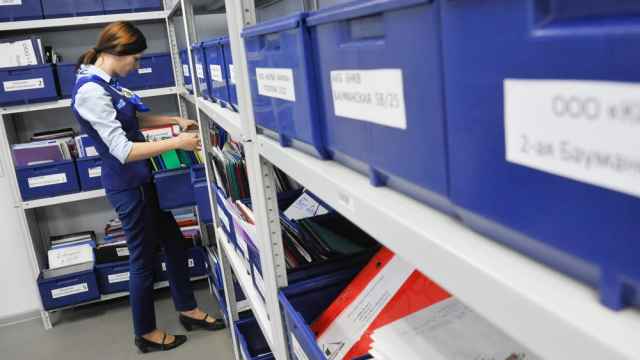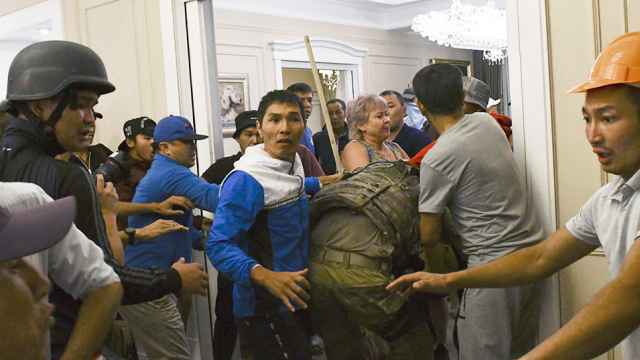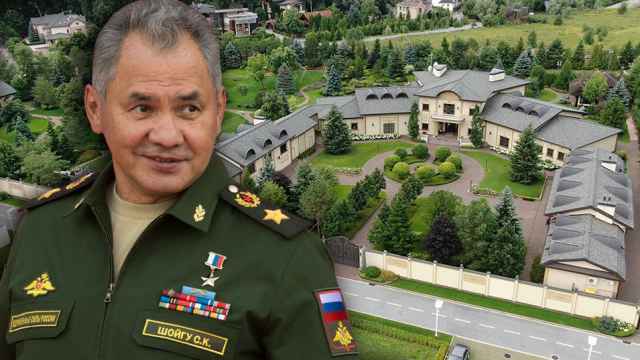The crash at Moscow’s Sheremetyevo Airport that killed 41 people on Sunday hasn’t been fully explained yet. Yet it should serve as a reminder that post-imperial ambitions have a cost, including in human lives.
The doomed Aeroflot Sukhoi Superjet 100 had returned to the airport some 30 minutes after takeoff due to a lighting strike, then made a hard landing and burst into flames as it bounced on the runway. The SSJ 100 is the only passenger airplane designed in Russia after the breakup of the Soviet Union that is used commercially today. The malfunction-prone plane is a headline project of the Putin era, an attempt to leverage the expertise of fighter-plane maker Sukhoi to claw back some Soviet-era airplane-building glory. It should be clear by now that the attempt has failed, at least for the time being.
The former empire prided itself on not using imported planes as a matter of national security. The Soviet aircraft industry employed some 2 million people at the end of the 1980s, and about 150 civilian airplanes a year were produced.
But in the mid-1990s, the industry died a painful death as impoverished Russians flew less and the Boeing-Airbus duopoly outcompeted the Soviet factories and design firms. After President Vladimir Putin came to power in 2000, the Russian government made a concerted effort to re-nationalize what was left of the Soviet aircraft industry and bring new planes to market. Making planes in Russia was for Putin a matter of national prestige, a sign that Russia remained a great power on a par with the U.S. and Europe and ahead of China (which, in recent years, has also made an effort to compete with passenger jets of its own, made by a state-owned company).
The Sukhoi project, proposed by a company without experience making civilian planes but with a history of successful warplane exports, was chosen in 2002 over another one, based on designs from the Tupolev organization, and became pretty much the only government-backed project in the industry by 2006. It received direct state financing and loans from state-controlled banks. Boeing was a high-profile consultant on the project, and parts were sourced from some 40 companies based in 10 countries.
The future looked reasonably bright at first for the SSJ, which was finally certified to fly in 2011. That year, the low-cost Mexican airline Interjet ordered 30 of the planes, lured by a low introductory price. There was interest from other buyers outside Russia, too. But in May, 2012, an SSJ 100 crashed into an Indonesian mountainside during a demonstration flight, killing 37 prospective clients and journalists as well as two Sukhoi representatives and six crew members. The crash was blamed on pilot error, but a major accident so early in the plane’s history undermined confidence in it — for good reasons, as it later transpired.
As foreign interest largely dried up, the government pushed the SSJs on Russian airlines, primarily Aeroflot, which agreed to take 50 of the planes if Sukhoi, part of the state-controlled United Aircraft Building Corporation, compensated it for downtime. The compensation made the huge deal unprofitable for the manufacturer but tolerable for Aeroflot. Now, 106 of the 139 SSJs in commercial use fly for Russian airlines.
Neither the airlines nor Russian regulators publish statistics on how the planes are used, but available sources show that airlines are having trouble keeping the SSJs in the air. According to leaked data for 2018, the average SSJ 100 used by a Russian airline flies for about 109 hours a month, roughly a third as much as a Boeing or an Airbus and slightly more than half as much as Brazilian-made Embraer-170s with about as many seats (78 versus 87 for Aeroflot’s SSJs).
The Superjet has proved unreliable for the few foreign buyers that took a chance on it, too. Earlier this year, the only European company that used SSJs, Ireland-based CityJet, returned all seven of its Russian planes to the leasing company. Mexico’s Interjet, the original buyer, has been forced to cannibalize some of the planes because of a parts shortage and a lack of Sukhoi service infrastructure in the Americas. Last year, Sukhoi was forced to reimburse the airline for persistent technical faults.
Last month, a much-touted contract for 15 SSJs with Slovenia’s Adria Airways was unexpectedly canceled. It was clear even before Sunday’s crash that Sukhoi’s initial plans to sell 800 Superjets by 2024, 500 of them outside Russia, were dead.
Though the Russian authorities haven’t grounded the Superjet, the fatal crash — the second major one in its less than 10-year history despite the small number of planes in use — will further undermine its reputation regardless of the outcome of the investigation. More than a decade of Russian government investment into the idea that Russia can be a competitive aircraft maker so far has delivered proof to the contrary.
The SSJ should be grounded pending a thorough investigation. That's what U.S. authorities did, albeit reluctantly and under pressure, when faced with evidence of recurring problems with the Boeing 737 Max, even though the reputational damage and potential for financial losses are much higher in Boeing's case than in the Superjet's. That the Aeroflot SSJ, originally bound for the northern city of Murmansk, only caught fire on the ground, making it impossible to save more than half of the 78 people on board, suggests the presence of dangerous design defects even more serious than the frequent technical problems.
As for the post-imperial ambition of reviving Soviet aircraft manufacturing, there’s no need to rush it even in the face of competition with China (which hasn’t been particularly successful with its aircraft project, either). Russia’s engineering brainpower and strong legacy in the industry should make it possible to produce good commercial planes someday.
Earlier this year, Putin urged Russian aircraft builders to work on a civilian version of the Tu-160 supersonic strategic bomber. Russia does make strongly competitive warplanes, and that gives it a lot to build on. But the ill-fated SSJ project should serve as a warning against haste and hype. Malfunctioning planes can kill people. Humility, caution and perfectionism, as a rule, don’t.
This article was originally published in Bloomberg Content.
A Message from The Moscow Times:
Dear readers,
We are facing unprecedented challenges. Russia's Prosecutor General's Office has designated The Moscow Times as an "undesirable" organization, criminalizing our work and putting our staff at risk of prosecution. This follows our earlier unjust labeling as a "foreign agent."
These actions are direct attempts to silence independent journalism in Russia. The authorities claim our work "discredits the decisions of the Russian leadership." We see things differently: we strive to provide accurate, unbiased reporting on Russia.
We, the journalists of The Moscow Times, refuse to be silenced. But to continue our work, we need your help.
Your support, no matter how small, makes a world of difference. If you can, please support us monthly starting from just $2. It's quick to set up, and every contribution makes a significant impact.
By supporting The Moscow Times, you're defending open, independent journalism in the face of repression. Thank you for standing with us.
Remind me later.








